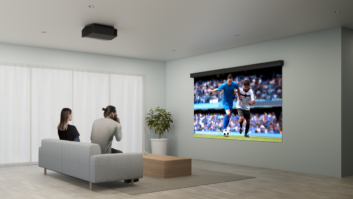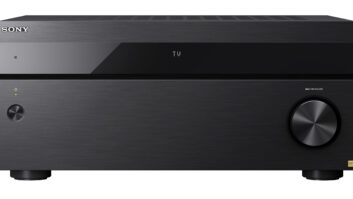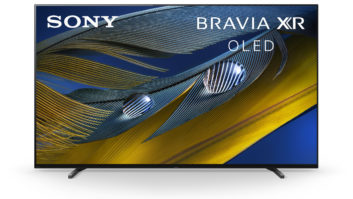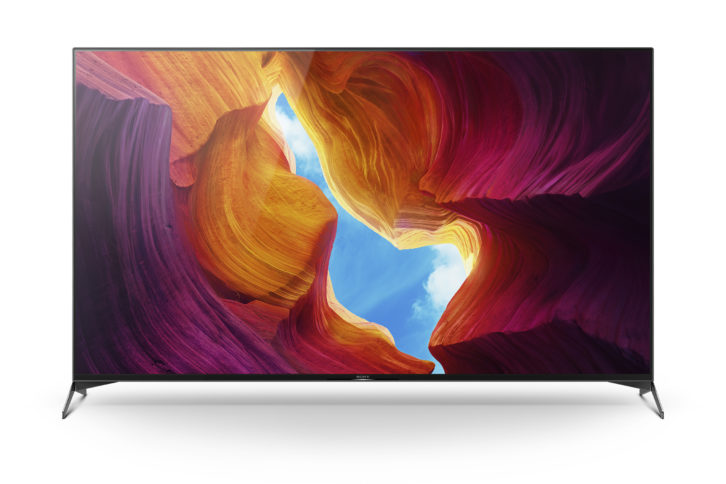
Does any consumer electronics category change more frequently than video? I mean, companies might go years between a speaker refresh, and you can expect a new receiver line-up every couple of years, but it seems like video manufacturers continue upping the ante almost every single year.
I can still remember the first time I saw an HDTV; it was at a CEDIA Expo and almost every booth was showing the same thing (Texas Wild) because there was so little content. But even still, you’d stop in your tracks at each booth and watch that rattlesnake’s scales stretch and contract as it slithered over the desert because it was so next-level compared to anything you’d seen before.
Nowadays, people are much harder to impress. They’ve been living with HD programming for years, and can turn on Netflix, Vudu, Amazon, or Disney+ and stream a massive amount of content in 4K HDR, and they just expect that images will look great. And, truth is, even cheap TVs look pretty darn good showing this content.
But if viewers know what to look for — and you demonstrate the differences — top-tier displays produce noticeably better and more accurate images, and if you have a demanding customer that requires a flagship display for critical viewing, Sony’s new X950H series might be just the ticket.
Standing at the top of Sony’s 2020 4K LED lineup (the step-up Z-series is 8K and only offered in the largest sizes), the X950H series is a Full Array LED panel with multiple dimming zones for deep blacks and includes other flagship Sony technologies like the premium X1 Ultimate picture processor, X-Wide Angle technology for improved off-angle viewing, Super Bit-Mapping to reduce banding, and X-tended Dynamic Range PRO for premium contrast. This series also supports DolbyVision and HLG (if that ever becomes a thing), Netflix Calibrated mode, and is IMAX Enhanced certified. Offered in sizes from 49 to 85 inches, the 950H series is surprisingly affordable for a flagship set, with the 65-inch review model I received retailing for $1699 (*remembers paying $6500 for 60-inch 9G Pioneer Elite plasma*).
Appearance
I installed the TV on its included feet, which Sony calls a “Premium Blade Stand.” The incredibly minimalist design feet can either position on the extreme sides of the display, or more in the middle for narrow table-tops. I have to say, as sleek as it looks, I didn’t love the stand. For one, it doesn’t fully mate into the bottom of the display, leaving a bit of a gap that looks like maybe it isn’t in all the way, and, for two, the display doesn’t sit up square-and-level at 90 degrees but leans back just a tad and has a bit of wobble to it if touched. Not enough that it feels like it would fall forward, but again that it just maybe isn’t installed correctly.
What I did like about the stand is that it holds the TV up just enough (about 2 7/8 inches) for the new Sony HTG700 soundbar to slide beneath it for a perfect fit. Of course, most of the TVs we sell/install will likely be wall-mounted (this set is VESA 300×300 btw), but it bothered me enough that I felt it was worth mentioning.
The set is attractive and has a luxury appearance when off, incorporating Sony’s “slim and simple one-slate design” that has a narrow aluminum bezel that is titanium-grey colored and smoothly rounded at the corners. The back of the set is also finished in a textured black that isn’t an eyesore should it be on display.
All of the inputs reside in a recessed compartment on back and connect from the side so as not to impede wall-mounting, and include four full bandwidth HDMI connections with HDCP 2.3 (with HDMI3 supporting eARC), two USB connections, a mini-jack that accepts composite video and analog audio, and a mini-jack audio out, as well as Toslink digital. On top of 2.4/5G Wi-Fi, the set also includes an Ethernet connection as well as RS-232 and IR inputs, so no need for an emitter to mar the front panel! The set also has Bluetooth A2DP headphone support, which is becoming a more requested feature.
Smart TV and Control
Sony smart TVs have been running on Android for some time, and the 950H uses Android 9.0 Pie with 16 GB on-board storage. New here is that Android runs on a separate System-on-Chip processor, resulting in zippy response, letting you quickly jump in and out of different apps or menus. As more people cut the cord, this near-seamless transition between smart services is noticeable and very welcome. Also cool is that you can customize and arrange the home screen, choosing what apps to display and sorting the order. You can also modify a quick-access settings bar, letting you quickly jump into things like picture modes, settings, network configuration, etc. It also supports more than 5000 apps, with Apple TV+ announced as coming at Apple’s recent WWDC.
I don’t generally put much stock in OEM remotes, but I have to say the included remote here is quite useful. For one, the remote has a built-in microphone for Google Assistant voice control, which we used extensively to turn lights off around the home and search for programming within apps. For another, it can pair with certain set-top boxes (Comcast, DISH, DirecTV, TiVo Bolt, Charter, and Spectrum) providing full STB control. After pairing with my DISH Joey, the Sony remote could do everything the original DISH remote could. Finally, with HDMI-CEC, the TV automatically recognized my connected Samsung 4K UltraHD Blu-ray player and the remote operated that. This was a universal remote experience without needing a separate remote. But, as is Sony’s maddening habit, the remote isn’t backlit, killing what otherwise could have been a fantastic controller. Often, I had to pull my phone out to navigate the remote in my dark viewing room, a problem that could have been resolved with about $.25 worth of LEDs. Bummer.
On the integration front, Sony supports Alexa integration and has drivers for the majority of automation systems, including an option in the Network settings to turn on an “announcement” for Control4’s SDDP. Once engaged, the TV appeared in my Composer (Control4’s programming software) device list, letting me drag it into my project. Along with Chromecast, the 950H also supports Apple Airplay2 and HomeKit integration, letting iOS users easily screen-mirror via AirPlay to the TV, allowing a fast and simple way to share photos and videos from an iPhone or iPad without any other hardware. The set also has an integrated microphone (that can be turned off) for hands-free Google Assistant operation.
Audio Quality (Featuring the HT-G700 Soundbar)
Generally, modern TVs aren’t known for their sound quality, but Sony at least makes an effort here with a few new audio upgrades known as Acoustic Multi-Audio. First, the set employs a new teardrop-shaped X-balanced speaker design for the bottom-mounted “woofers,” allowing higher quality audio while retaining the set’s thin design. In addition, there are two new Sound Positioning Tweeters located high-up on the back sides of the set. These significantly raise the soundstage, better marrying dialog to the screen center and delivering some decent width and space to the soundstage. Further, a new bi-amplified design sends more power to each speaker, enhancing dialog and bass. Finally, the remote’s built-in microphone is used to perform an in-room audio calibration to further tweak the sound. The result is surprisingly decent audio quality that will definitely suffice for most bedroom installations.
To accompany the TV, Sony also sent its new HT-G700 3.1-channel Dolby Atmos soundbar. As mentioned earlier, the G700 slides neatly under the X950H on its tabletop stand, making it significantly less noticeable and not encroaching on the screen. (Of course, it can also be wall mounted.) Setup was as simple as plugging the bar and included wireless sub into power, connecting to the TV’s HDMI3 eARC capable output, and enabling eARC in the TV’s audio settings. (The bar also has a Toslink optical and separate HDMI input if the display doesn’t support ARC/eARC.) Bluetooth 5.0 is also on board for simple music streaming.
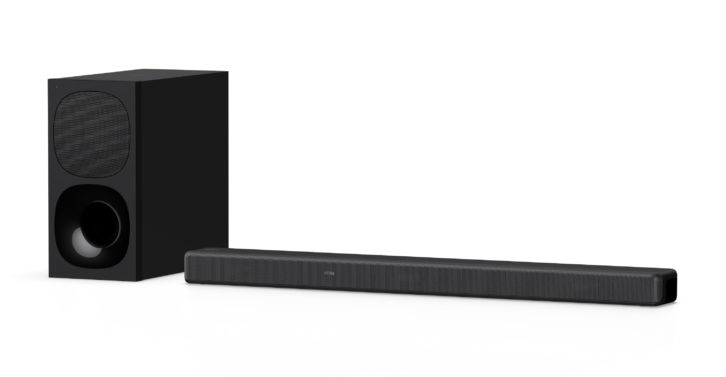
Beyond the DD+ audio from streaming services, I popped in a 4K Blu-ray to confirm the TV was indeed passing the lossless Dolby TrueHD audio signal and the bar was decoding Dolby Atmos. In all cases, the G700 improved the audio experience, delivering low-end the TV couldn’t hope to match, and supplying a far more cinematic experience. The bar also provided significantly more width, height, and space to the presentation, not quite placing sounds over my head, but definitely high up on the front wall and well out to the sides. The 400-watts total power feeding bar and sub also produced plenty of volume and low-end, and the G700 would make a great add-on for customers looking for an affordable way to greatly improve their AV experience.
I did have a couple of issues with my soundbar review sample that are worth mentioning. One involved the subwoofer randomly unpairing from the bar; I’d notice that audio was thin with no sub playing, and a simple power cycle on the sub restored operation. Another was losing the first 2-3 seconds of audio when switching between programming in streaming services, so the first moments of a show or cutting to/from ads in Hulu were silent. I can’t say whether this was an issue just with my review sample, an eARC handshake quirk, or something else, but felt it worth mentioning. [For John’s full review of the HT-G700 soundbar, click here.]
Picture Quality
Now, on to the main event: the XBR65X950H’s picture quality!
I watched hours of content on the display, ranging from 4K Blu-rays/Kaleidescape, to streaming content across a variety of providers, to HD programming via DISH, and images were consistently fantastic. None of my previous displays supported Dolby Vision, and rewatching things like Pixar’s Inside Out on Disney+ or Blade Runner 2049 on Vudu produced some of the finest images I’ve ever seen, with incredibly vibrant colors and deep, rich shadow detail. And as much as I dislike the movie, I couldn’t help but watch Billy Lynn’s Long Halftime Walk in 4K/60 as it just looked so good. Close-ups bristled with detail, showing pinpoint stitching in fabric, single strands of hair, and every wrinkle and line in actors’ faces.
What consistently impressed me was the set’s stunning black levels. Viewing in a totally darkened environment, cuts to black were completely black. Even “torture” scenes like an all-black screen with a single white credit had just a bit of deep grey bloom around the credit with pure blacks elsewhere. Running the FALD zone counter on the Spears & Munsil UHD HDR Benchmark disc, it appears the set has 48 zones of dimming. Part of what the X1 Ultimate processor does with its dual database is continuously analyzing content to make intelligent dimming and lighting zone decisions, with X-tended Dynamic Range able to push extra light to zones that need it, resulting in better, more dynamic HDR content.
With even a bit of ambient light in the room, this bloom wasn’t visible, giving the set OLED-like black levels. It was only when viewing patterns like the S&M FALD counter, single-pixel test, or starfield pattern in a totally black room did you notice that the light bleed from the X950H’s lighting zones that couldn’t compete with OLED’s true pixel-level dimming. However, the trade-off is that OLED sets can’t compete with the 950H’s brightness and light output, and in many cases the extra brightness will be more noticeable — and enjoyable — than those lowest nits.
Another big upsell of the 950H series is its X-Wide Angle panel that produces brighter, more saturated, and accurate colors from off-angle viewing. Walking far left and right of the screen I definitely noticed far less light and color shift than from other LED sets, and for rooms where there is a wide array of seating, the 950H will give a better picture to those not in the money seats.
Only rarely did I notice any kinds of artifacts such as a bit of streaking in certain scenes in Top of the Lake on Hulu, or some juddery motion issues during The Alienist on DISH, but these were either things in the source or addressed by tweaking settings in the display. I also loved the Super Bit Mapping feature that helps reduce banding.
While the display is IMAX Enhanced certified, there was some hiccup during my review period where I was unable to access any IE content on FandangoNOW — the primary source of IE streamed content — so I wasn’t able to check out any of this content. I’m sure this is some backend issue between Sony and FandangoNOW that will be resolved.
Interestingly (Surprisingly? Disappointingly?) while this is Sony’s flagship 4K LED, it does not merit Sony’s recently introduced “Ready For PlayStation 5” tag, as it doesn’t support next-gen HDMI 2.1 features such as 4K at 120 Hz, variable refresh rates, or Automatic Low Latency Mode. Surprisingly, the step-down X900H models do support these features (and receive the “Ready For” badge), with lag times of 7.2ms in Game Mode, compared to 18.5ms for the 950H. For serious gamers, this might be a dealbreaker.
Sony’s X950H series offers videophiles a ton to love, likely producing some of the finest eye-candy they have ever seen. Granted, OLED offers a viable step-up option for those without a budget who primarily watch in a totally light-controlled environment, but for customers with any ambient lighting, a bit less cash to spend, and any burn-in concerns, the X950H is a real stunner.
877-865-7669; SONY.COM
Kudos: Fantastic picture quality; near OLED-level blacks; zippy response; surprisingly decent sound
Concerns: Non-backlit remote; tabletop stand; lack of next-gen gaming features
Product Specs:
- Full Array Local Dimming 4K UltraHD LED TV
- Picture Processor X1 Ultimate with dual database processing
- X-Wide Angle panel design provides superior off-angle viewing with better color reproduction and contrast
- IMAX Enhanced Certified, Dolby Vision, Netflix Calibrated
- Android 9.0 Pie with hands-free Google Assistant
- Acoustic Multi-Audio bi-amplified speaker system with two full range X-balanced bass reflex speakers and two sound positioning tweeters
- Inputs: four HDMI inputs with HDCP 2.3 (HDMI 3 supports eARC), two USB, mini-jack composite and analog audio, Ethernet, mini-jack IR, mini-jack RS-232; Outputs: mini-jack analog audio, Toslink digital
- Dimensions: 57 1/8 x 32 7/8 x 3 1/4-inches (WxHxD without stand); 49.2 pounds





